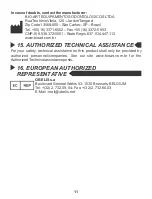
4
-
With the tank duly filled in and introduced in Microblaster, press the switch
button (04) to start the blasting process.
Remark:
If the blasting is interrupted for any reason even with the switch button (04)
pressed and the tank (06) filled in with abrasive, follow the steps below:
• keep the switch button (04) pressed;
• with the other hand, hold the hose firmly in the region close to the end of the
Microblaster body, pulling slightly and releasing immediately afterwards;
• repeat this procedure until the air passage is free.
5
- Always try to keep a distance from 5 to 10 mm between the face of the
Microblaster needle tip (01) and the surface to be worked during blasting.
Important note:
• In order to obtain better results during the blasting works, make small fast and
constant movements throughout the whole surface to be blasted.
• Some recommendations for the aluminum oxide granulation, indicated for some
application examples are presented below. It is upon the professional's discretion
to choose the best applicable granulation, provided that it is supported by
Microblaster (up to 100 microns).
Applications Granulation
Micro-retentions (surface roughness)
50 microns
90 microns
50 microns
50 microns
50 microns
50 microns
50 microns
90 microns
90 microns
90 microns
Bracket recycling (cleaning)
Internal "inlay-onlay" cleaning of resin and ceramics
Internal evidencing for crown adjustment and seating
Occlusal blasting for fine-tuning, replacing the use
of carbon
Adjustment of interproximal contacts
Cleaning of cast parts
Removal of oxidation
Removal of cement from metal crowns, resins, ceramics
and other materials
Cleaning or degreasing of metal and/or ceramics when the
"intraoral ceramic repair technique" is used
6
































